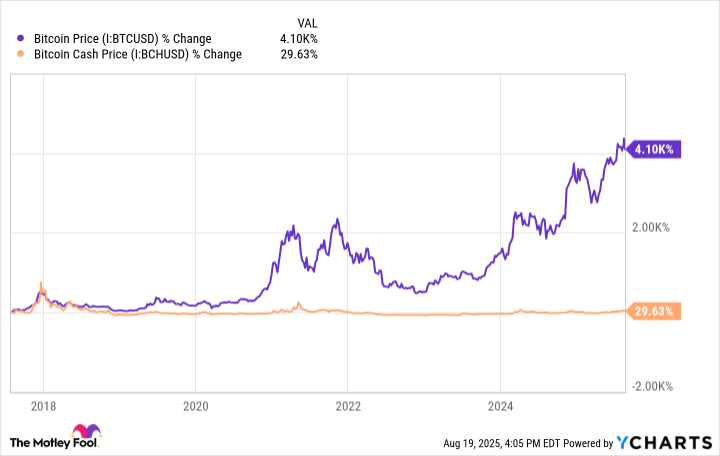Cryptocurrency investing is a high-risk venture. Your portfolio could deliver incredible returns if you invest in quality projects, but if you don't, you could lose most or all of your money. Unfortunately, the market is full of crypto scams and low-quality coins that do little but disappoint investors.
A sum of $2,500 is a good starting point for a crypto portfolio. To ensure it doesn't go to waste, here are three popular cryptocurrencies to avoid, along with some better alternatives.
1. Dogecoin and its fellow meme coins are digital lottery tickets
Created in 2013, Dogecoin (DOGE 3.81%) started the trend of meme coins. These cryptocurrencies are based on memes -- in Dogecoin's case, the "doge" meme that was popular back then -- or just have humorous characteristics and don't take themselves too seriously. More recent examples include Shiba Inu, Pepe, and Official Trump.
Some meme coins skyrocket in price but usually only briefly, and it's not because of any value or utility they provide. Dogecoin's biggest bull run coincided with Elon Musk tweeting about it and saying it might be his favorite cryptocurrency. It also took off after the 2024 presidential election because of Musk's ties to President Trump.

CRYPTO: DOGE
Key Data Points
While meme coins can be an amusing diversion, buying them is more akin to gambling than investing. I wouldn't invest in a business that doesn't take itself seriously, and meme coins are the cryptocurrency version of that.
2. Tether and other stablecoins are a currency, not an investment
Tether (USDT 0.05%) is the biggest stablecoin, with a market cap of about $167 billion (as of Aug. 19). The stablecoin market as a whole is worth $288 billion.
Stablecoins have been in the news lately. Last month, the U.S. passed the Genius Act, which provides a regulatory framework for stablecoins. Standard Chartered, a British bank, forecasts that the stablecoin market could be worth $2 trillion by 2028. Circle, issuer of the USDC stablecoin, had its initial public offering (IPO) in June.
Even though stablecoins are a hot topic at the moment, it's important to realize that they're not an investment. The purpose of a stablecoin is to maintain a peg to the value of another asset. For example, Tether is a U.S. dollar stablecoin, and 1 Tether USD (USDT) should ideally always be worth $1. Stablecoins are useful for payments, but if you're going to put $2,500 in cryptocurrency, you probably want to buy coins designed to grow in value.
3. Bitcoin Cash is an unsuccessful spin-off of the top cryptocurrency
Nobody likes a lousy spin-off. In 2017, a dispute about a proposed Bitcoin upgrade led to a hard fork in its blockchain. Bitcoin continued on with its upgrade, and a new blockchain was split off for Bitcoin Cash (BCH 2.95%).
At first glance, Bitcoin Cash may look like a cheaper alternative to Bitcoin. It's still a top-20 cryptocurrency, and it costs about $550, whereas Bitcoin is about $113,000 at the moment. They actually have very different purposes, with Bitcoin Cash focused on being a digital currency and Bitcoin a store of value.
That's reflected in their returns over the years. Since Bitcoin Cash started in 2017, it's up 30%. Bitcoin is up 4,100%.
Bitcoin Price data by YCharts.
Bitcoin Cash may be useful as a digital currency, although stablecoins are likely a better option because they're designed to maintain a stable value. As an investment, the original Bitcoin is a much better choice.
Which cryptocurrencies should you buy?
If you're a new crypto investor, consider starting your portfolio with Bitcoin and Ethereum. They've been the top two cryptocurrencies for years and have survived multiple bear markets. They also have legitimate use cases. Bitcoin, as mentioned earlier, is a digital store of value. Ethereum is a smart contract blockchain with decentralized apps and services, including decentralized finance (DeFi) protocols.
There are plenty of other interesting crypto projects to invest in. You may want to look into more types of cryptocurrency to see what they do and the problems they intend to solve, so you can pick the ones you like.
Cryptocurrencies are volatile and risky, and that includes Bitcoin and Ethereum. The safest approach to crypto investing is to make it a small portion (1% to 5%) of your portfolio and only put in money you can afford to lose.








